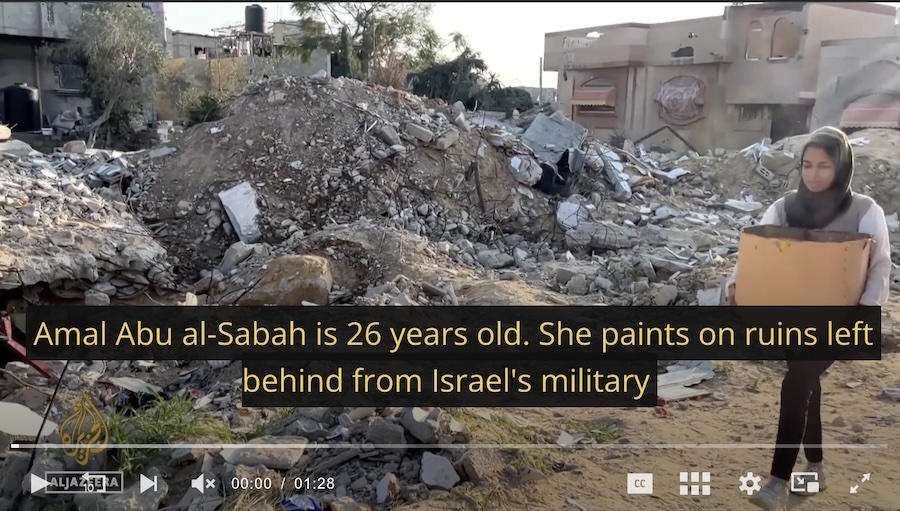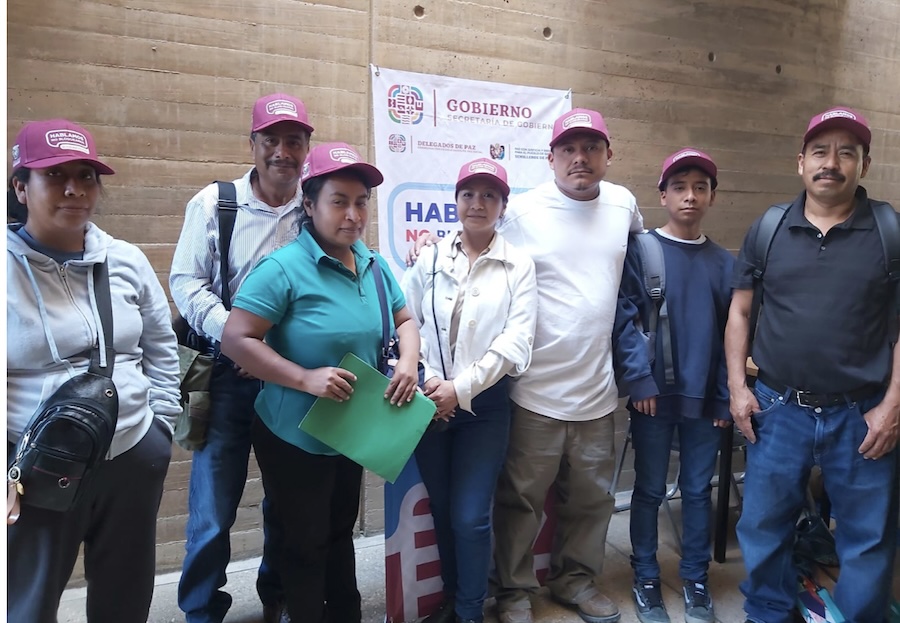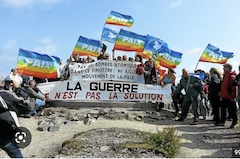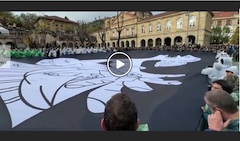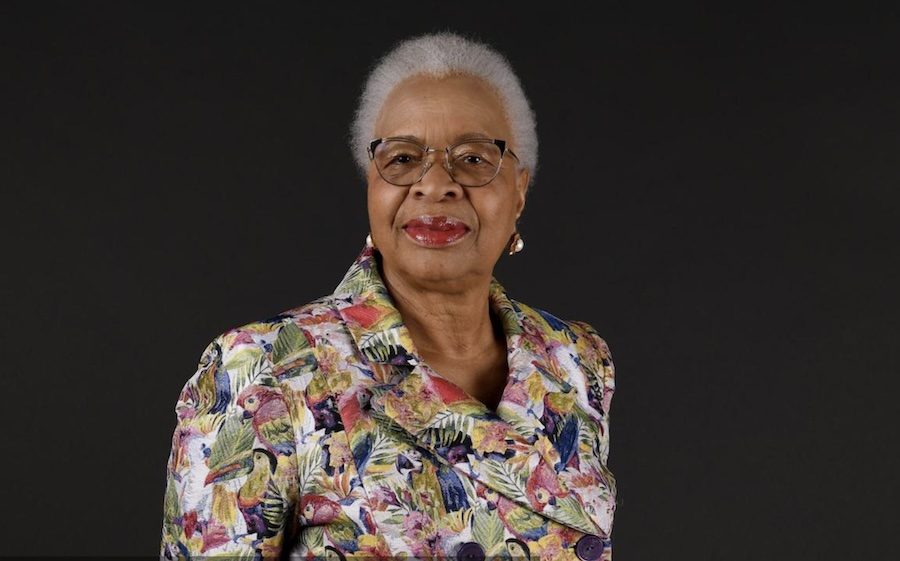. . HUMAN RIGHTS . .
An article from the BDS Movement
The Palestinian BDS National Committee (BNC), the largest coalition in Palestinian society that is leading the global Boycott, Divestment and Sanctions (BDS) movement, salutes activists, organizations and institutions worldwide that have expressed meaningful solidarity with our urgent struggle to stop Israel’s unfolding genocide in Gaza by escalating boycott and divestment campaigns. The spreading boycotts of complicit Israeli and multinational corporations can be effective if done strategically.
Below is a detailed guide of our targeted consumer boycotts, divestment and pressure campaigns. Help us spread the word to maximize our impact!
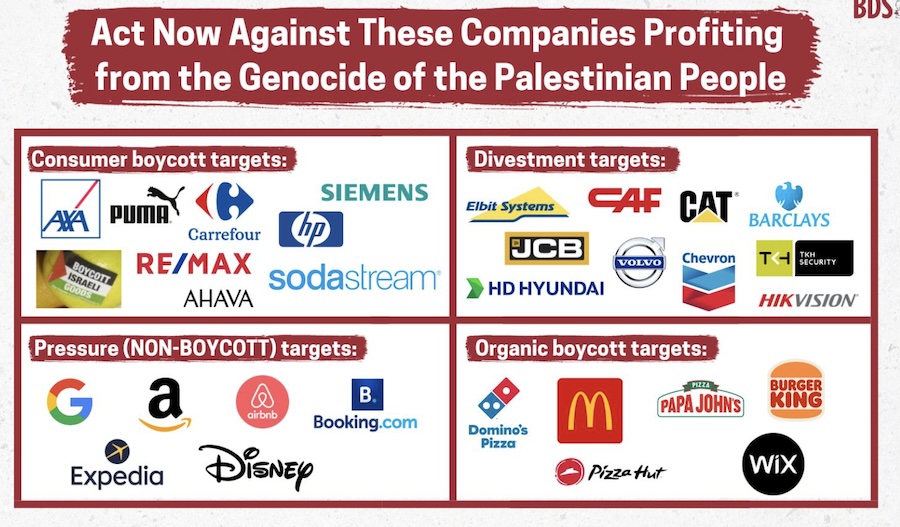
(Click on image to enlarge)
Ending all state, corporate and institutional complicity with Israel’s genocidal regime is more urgent than ever. Our lives and livelihoods literally depend on it.
Targeted Boycotts vs. Non-targeted Boycotts
People of conscience around the world are rightfully shattered, enraged, and sometimes feeling powerless. Many feel compelled to boycott any and all products and services of companies tied in any way to Israel. The proliferation of extensive “boycott lists” on social media is an example of this. The question is how to make boycotts effective and actually have an impact in holding corporations accountable for their complicity in the suffering of Palestinians?
The BDS movement uses the historically successful method of targeted boycotts inspired by the South African anti-apartheid movement, the US Civil Rights movement, the Indian anti-colonial struggle, among others worldwide.
We must strategically focus on a relatively smaller number of carefully selected companies and products for maximum impact. We need to focus on companies that play a clear and direct role in Israel’s crimes and where there is real potential for winning, as was the case with, among others, G4S, Veolia, Orange, Ben & Jerry’s and Pillsbury. Compelling huge, complicit companies, through strategic and context-sensitive boycott and divestment campaigns, to end their complicity in Israeli apartheid and war crimes against Palestinians sends a very powerful message to hundreds of other complicit companies that “your time will come, so get out before it’s too late!”
Many of the prohibitively long lists going viral on social media do the exact opposite of this strategic and impactful approach. They include hundreds of companies, many without credible evidence of their connection to Israel’s regime of oppression against Palestinians, making them ineffective.
That being said, all peaceful popular efforts, including boycott and divestment, to hold all genuinely complicit corporations (and institutions) accountable for supporting Israel’s grave violations of Palestinian rights are justified and called for. It is perfectly legitimate, for instance, to boycott companies whose Israeli branch or franchise has supported Israel’s unfolding genocide in Gaza, some of which we mention below in the grassroots organic boycott targets section.
Also, a company or product may make perfect sense as a boycott target in one context or city but not another. This context-sensitivity is a key principle of our movement. Regardless, we all have limited human capacity, so we’d better use it in the most effective way to achieve meaningful, sustainable results that can truly contribute to Palestinian liberation. We therefore call on our supporters to strengthen our targeted campaigns and boycott the complicit companies named on our website to maximize our collective impact.
The following are the current top priority boycott targets of the global BDS movement.
We have split these targets into four sections:
1. Consumer boycott targets – The BDS movement calls for a complete boycott of these brands carefully selected due to the company’s proven record of complicity in Israeli apartheid.
2. Divestment targets – The BDS movement is pressuring governments, institutions and investment funds to exclude and divest from as many complicit companies as practical, especially weapons manufacturers, banks, and companies listed in the UN database of business involved in Israel’s illegal settlement enterprise, as well as the WhoProfits and AFSC Investigate databases of companies enabling the occupation. Below we give some of the targets we are campaigning against.
3. Pressure (non-boycott) targets – The BDS movement actively calls for pressure campaigns against these brands and services due to their complicity in Israeli apartheid. We have not, on strategic grounds, called for a boycott of these brands and services, instead we strategically call on supporters and institutions to mount other forms of pressure on them until they end their complicity in Israeli apartheid.
4. Organic boycott targets – The BDS movement did not initiate these grassroots boycott campaigns but is in support of them due to these brands openly supporting Israel’s genocide against Palestinians.
1. Consumer boycott targets:
Siemens
Siemens (Germany) is the main contractor for the Euro-Asia Interconnector, an Israel-EU submarine electricity cable that is planned to connect Israel’s illegal settlements in the occupied Palestinian territory to Europe. Siemens-branded electrical appliances are sold globally.
PUMA
Since 2018 we have called for a boycott of PUMA (Germany) due to its sponsorship of the Israel Football Association, which governs teams in Israel’s illegal settlements on occupied Palestinian land. In a major BDS win in December 2023, PUMA leaked news to the media that it will not be renewing its contract when it expires in December 2024. We continue to call for #BoycottPUMA until it ends its complicity in Israeli apartheid.
Carrefour
Carrefour (France) is a genocide enabler. Carrefour-Israel has supported Israeli soldiers partaking in the unfolding genocide of Palestinians in Gaza with gifts of personal packages. In 2022, it entered a partnership with the Israeli company Electra Consumer Products and its subsidiary Yenot Bitan, both of which are involved in grave violations against the Palestinian people.
AXA
When Russia invaded Ukraine, insurance giant AXA (France) took targeted measures against it. Yet, as Israel, a 75-year-old regime of settler-colonialism and apartheid, wages a genocidal war on Gaza, AXA continues to invest in Israeli banks financing war crimes and the theft of Palestinian land and natural resources.
(continued in right column)
Question related to this article:
How can war crimes be documented, stopped, punished and prevented?
(continued from left column)
Hewlett Packard Inc (HP Inc)
HP Inc (US) provides services to the offices of genocide leaders, Israeli PM Netanyahu and Financial Minister Smotrich.
SodaStream
SodaStream is actively complicit in Israel’s policy of displacing the indigenous Bedouin-Palestinian citizens of Israel in the Naqab (Negev) and has a long history of racial discrimination against Palestinian workers.
Ahava
Ahava cosmetics has its production site, visitor center, and main store in an illegal Israeli settlement in the occupied Palestinian territory.
RE/MAX
RE/MAX (US) markets and sells property in illegal Israeli settlements built on stolen Palestinian land, thus enabling Israel’s colonization of the occupied West Bank.
Israeli produce in your supermarkets
Fruits, vegetables, and wines misleadingly labeled as “Product of Israel” often include products of illegal settlements on stolen Palestinian land. Israeli companies do not distinguish between the two, and neither should consumers. Boycott produce from Israel in your supermarket and demand their removal from shelves.
2. Divestment targets:
Elbit Systems
Elbit Systems is apartheid Israel’s largest arms company. It “field-tests” its weapons on Palestinians, including in Israel’s ongoing genocidal war on Palestinians in Gaza. On top of building killer drones, Elbit makes surveillance technology for Israel’s apartheid wall, checkpoints and Gaza fence, enabling apartheid. The US and EU use Elbit’s technology to militarize their borders, violating refugee and indigenous peoples’ rights.
HD Hyundai/Volvo/CAT/JCB
Machinery from HD Hyundai (South Korea), Volvo (Sweden/China), CAT (US), and JCB (UK) has been used by Israel in the ethnic cleansing and forced displacement of Palestinians through the destruction of their homes, farms, and businesses, as well as the construction of illegal settlements on land stolen from them, a war crime under international law.
Barclays
Barclays Bank (UK) holds more than £1 billion in shares of, and provides more than £3bn in loans and underwriting to nine companies whose weapons, components and military technology have been used in Israel’s armed violence against Palestinians.
CAF
Basque transport firm, CAF, builds and services the Jerusalem Light Rail (JLR), a tram line that serves Israel’s illegal settlements in Jerusalem. CAF benefits from Israel’s war crimes on stolen Palestinian land.
Chevron
US fossil fuel multinational Chevron is the main international corporation extracting gas claimed by apartheid Israel in the East Mediterranean. Chevron generates billions in revenues, strengthening Israel’s war chest and apartheid system, and exacerbating the climate crisis.
HikVision
Amnesty International has documented high-resolution CCTV cameras made by the Chinese company Hikvision installed in residential areas and mounted to Israeli military infrastructure for surveillance of Palestinians. Some of these models, according to Hikvision’s own marketing, can plug into external facial recognition software.
TKH Security
Amnesty International has identified cameras made by the Dutch company TKH Security used by Israel for surveillance of Palestinians. TKH provides Israeli police with surveillance technology that is used to entrench apartheid.
3. Pressure (non-boycott) targets:
Google and Amazon (US)
As the Israeli military bombed homes, clinics, and schools in Gaza and threatened to push Palestinian families from their homes in occupied Jerusalem May 2021, Amazon Web Services and Google Cloud executives signed a $1.22 billion contract to provide cloud technology to the Israeli government and military. By supporting Israeli apartheid with vital technologies, Amazon and Google are directly implicated in its entire system of oppression, including its unfolding genocide in Gaza. Join the #NoTechForApartheid campaign. While the campaigns targeting these corporations have not called for boycotts, other forms of pressure have been adopted to force them to end their complicity.
Airbnb/Booking/Expedia
Airbnb (US), Booking.com (Netherlands) and Expedia (US) all offer rentals in illegal Israeli settlements built on stolen Palestinian land. While the campaigns targeting these corporations have not called for boycotts, yet, other forms of pressure have been adopted to force them to end their complicity.
Disney
The Disney-owned Marvel Studios (US) is promoting in the next Captain America film a “superhero” that personifies apartheid Israel. Both companies are therefore complicit in “anti-Palestinian racism, Israeli propaganda, and the glorification of settler-colonial violence against Indigenous people,” as Palestinian cultural organizations have stated.
4. Grassroots organic boycott targets:
McDonald’s (US), Burger King (US), Papa John’s (US), Pizza Hut (US), WIX (Israel), etc. are now being targeted in some countries by grassroots organic boycott campaigns, not initiated by the BDS movement, because these companies, or their branches or franchises in Israel, have openly supported apartheid Israel and/or provided generous in-kind donations to the Israeli military amid the current Israeli offensive against 2.3 million Palestinians in the occupied and besieged Gaza Strip–described by leading international scholars of international law as an “unfolding genocide.” If these grassroots campaigns are not already organically active in your area, we suggest focusing your energies on our strategic campaigns above.
Remember, all Israeli banks and virtually all Israeli companies are complicit to some degree in Israel’s system of occupation and apartheid, and hundreds of international corporations and banks are also deeply complicit. We focus our boycotts on a small number of companies and products for maximum impact.
Additional resources: To learn more about companies complicit in Israel’s abuses of Palestinian human rights visit Who Profits, Investigate, and the UN database of companies involved in Israel’s illegal settlement enterprise.
– – – – –
Comments
If you wish to make a comment on this article, you may write to coordinator@cpnn-world.org with the title “Comment on (name of article)” and we will put your comment on line. Because of the flood of spam, we have discontinued the direct application of comments.




